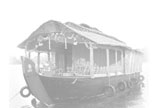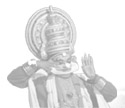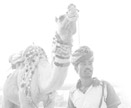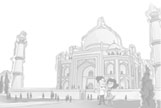
Home ››
Rajasthan Tour Packages ›› Rajasthan Tourist Attractions ›› Forts & Palaces
Rajasthan Forts and Palaces tell the history of erstwhile royal seat of the Rajputs. The Rajputs like the Mughals were prolific builders and have patronized some of the most distinguished and impressive forts and palaces in Rajasthan.
Almost every city of the Rajasthan is lined with splendid forts and palaces built by various rulers and architects.
These forts and palaces were generally built outside the walled city over the high hills to protect the city.
Rajasthan Tourist Attractions
FORTS & PALACES
Famous Forts & Palaces of Rajasthan
Amer Fort , Jaipur
Amber Fort is located in Amber (Jaipur), which used to be the capital of the Kachhwaha clan, till Jaipur was made the official capital in 1727. The Amber Fort looks stunning, all-built in white marble and red sandstone. To add to its charm, Maotha Lake makes its foreground. The crystal mirror image of the Fort, on the still waters of the lake, seems to be a beautiful illusion. Amber Fort is usually pronounced as Amer Fort. In 1592, construction of the Fort was started by Raja Man Singh I. However, the Amber Fort took its present form during the reign of Raja Jai Singh I.

The outer appearance of the Fort, being rough and craggy is totally different from its core. The interior of the Fort provides a soothing and warm ambience, which is least expected from its outer appearance. The marvelous decoration of the Amer Fort is influenced by both, the Hindu and Muslim manner of ornamentation. Exquisite paintings of hunting scenes on the walls depict the temperament of the Rajputs, who were adventurous, revolutionary and self-indulgent.
The intricate carvings on the walls and ceilings simply astonish the visitors. The minute mirror work adds to the grand appearance and royalty of the halls. The Amer Fort undoubtedly captivates the tourists with its artistic quality of delicate work. The mighty walls guarantee the protection of the Fort against the invasion of the enemies. The Fort is divided into four subparts.
City Palace , Jaipur
City Palace, JaipurCity Palace forms one of the most famous tourist attractions and a major landmark in Jaipur. The beautiful palace was built by Maharaja Sawai Jai Singh during his reign. Among the various forts and palaces of Jaipur, City Palace stands apart, with its outstanding art and architecture. City Palace complex covers a huge area, which is divided into a series of gardens, courtyards and buildings. Initially, Raja Jai Singh built the outer wall occupying a huge area. The additional grand buildings were constructed later by the succeeding rulers.
A part of the exquisite Palace still makes home for the former Maharaja/ King. The premises consists several buildings like Chandra Mahal, Mubarak Mahal, Mukut Mahal, Maharani's Palace, Shri Govind Dev Temple and the City Palace Museum. One would come across the Mubarak Mahal, as one enters the first square. Mubarak Mahal was built by Sawai Madho Singh in the 19th century to entertain his guests. Today, it has converted into a costume gallery, which displays royal attires of the Kings.
 Jaisalmer Fort
Jaisalmer Fort
Jaisalmer Fort Deep in the heart of the Thar Desert is Jaisalmer, one of the last princely bastions in the region. Founded on what was the cross - road of lucrative trade routes, this remote settlement came to be celebrated for the valour of its rulers, and for the aesthetic sense represented by their palaces and havelis. The rich merchants engaged stone - craftsmen who worked delicately on the sandstone mansions they built, filling up facades with sculptural filigree, screen windows, delicate pavilions and beautiful balconies. Today, these veritable art - museums are still inhabited, and their colourful celebrations and festivals have placed Jaisalmer Fort firmly on the world tourism map.
The golden - yellow sandstone of Jaisalmer Fort, over 800 years old, crowns the Trikuta Hill. Within its walls, defended by 99 turrets, lies the old city, nearly a quarter of modern Jaisalmer. Seen from outside, the sight must be almost identical to what was seen by merchants on their overland camel caravans to central Asia. Once this desert outpost was an important gate for the trade route, and Jaisalmer grew wealthy on the proceeds. But the advent of commercial shipping relegated the town to relative obscurity.
Mehrangarh Fort
Mehrangarh Fort,JodhpurSituated on a steep hill, Mehrangarh Fort is one of the largest forts in India. The fort has been a witness to the splendour of a bygone era. The beauty and the grandeur of numerous palaces in the fort narrates a saga of hard sandstones yielding to the chisels of skilled Jodhpuri sculptures. To enter the fort, seven gates have to be crossed.
Some of these gates still bear marks of many a siege that this fort has withstood. Its very hard to imagine how any invader even thought of conquering this fort, which at places has 17 feet thick and 68 feet high walls.
The Mehrangarh Fort encloses many palaces, which are known for their intricate carvings and sprawling courtyards. Moti Mahal or the Pearl Palace has a delicately carved stone screen and treasures the Sringar Chowki, royal throne of Jodhpur. Umaid Villas displays the Rajput miniature paintings and Ajit Villas exhibits musical instruments and the royal costumes. Both these villas are joined by a beautiful mirror room.
 Umaid Bhawan Palace, Jodhpur
Umaid Bhawan Palace, Jodhpur
Umaid Bhawan Palace, Udaipur TourismMaharaja Umaid Singhji who built this palace was fascinated with western lifestyles so he marshalled the services of a well-known Edwardian architect, Henry Vaughan Lanchester, a creditable equal of Edward Lutyens (architect of New Delhi) to construct a three hundred and forty seven roomed Umaid Palace.
This was to become India last of the great palaces and the biggest private residence in the world. Spectacular Central Rotunda, the cupola rises to a hundred and five feet high; the Throne Room with its exquisite Ramayana murals; an elegant wood-panelled library, and even a private museum; an indoor swimming pool, a Billiards Room, tennis courts and unique marble squash courts makes Umaid Bhawan Palace is unabashedly the most magnificent.
The palace was also built with superficial intentions of providing employment to famine stricken farmers. The Palace now is a five star deluxe palace hotel. The museum of the palace is highly recommended for its display of weapons, an array of stuffed leopards, a huge banner presented by Queen Victoria and an incredible collection of clocks.
Umaid Bhawan Palace, Jodhpur TravelThis is known as Umaid Bhawan Palace because of the particular type of sandstone used, to build it - which is not weathered. Portions of the Umaid palace have been converted into a hotel and a museum.
Located in the Thar Desert, Jodhpur is known for its impressive fortified bastions, specially those of Mehrangarh Fort, which has been a witness for many battles and is associated closely with the history of the region.
Being a part of the desert triangle, and venue of Marwar Festival it is also covered by the famous "Palace on Wheels", a super luxurious (emperor style) rail-cum-road package tour.
The city again is of high tourist attraction and has all basic amenities for both domestic and foreign tourists. Hotels from Super Deluxe ranging to low budge can be checked in. It is well connected by rail, road and air to the city as it again witnesses high flow of tourist traffic in winters.

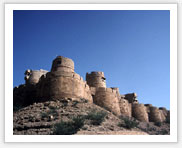 Plan a holiday trip to Rajasthan and you can have the pleasure to visit some of the largest forts in the world. Stroll around the spacious alleyways, courtyards and terraces of the forts where you can see the monument architecture and open-heartedly provide a magnificent view of the cities sprawled around.
Plan a holiday trip to Rajasthan and you can have the pleasure to visit some of the largest forts in the world. Stroll around the spacious alleyways, courtyards and terraces of the forts where you can see the monument architecture and open-heartedly provide a magnificent view of the cities sprawled around.